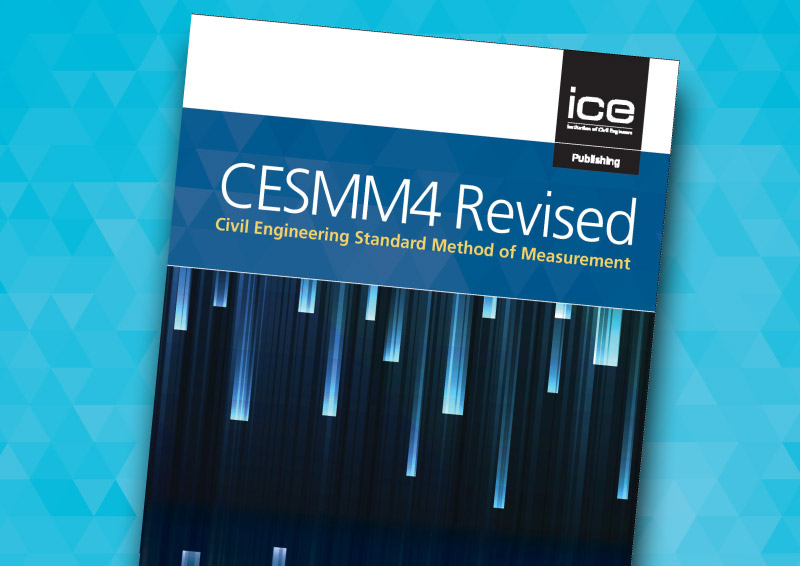The skills associated with preparing and using a Bill of Quantities are in danger of being lost to an industry which appears to be forgetting some of the benefits the Bill of Quantities can provide. Now that revised fourth edition of the Civil Engineering Standard Method of Measurement (CESMM) is published, Mike Attridge outlines the key benefits that a civil engineering Bill of Quantities (CEBoQ) can provide.

- Updated: 22 May 2019
- Author: Mike Attridge
CEBoQs have traditionally been prepared in accordance with the detailed rules described in the standard method of measurement for civil engineering works - CESMM.
For those unfamiliar with the idea of a CEBoQ, a useful starting point is the following description, deriving from CESMM4:
“The CEBoQ is a document prepared in accordance with the detailed rules of measurement described in CESMM4 and comprises a list of items that provide brief identifying descriptions and estimated quantities of the proposed civil engineering works”.
The principal benefits of the CEBoQ stem from its use as the means by which financial control can be exerted over civil engineering projects, and its (much under-rated) use as a means of controlling risk. These two benefits are of course complementary.
Risk Management
Well before tenders are invited for a civil engineering project, the very act of preparing a CEBoQ will have already yielded a major benefit to the client, albeit one that it may not be aware of.
The process and discipline involved with preparing a CEBoQ in accordance with the detailed rules of CESMM4 requires an extremely thorough interrogation of the drawings and specifications prepared by the designer. Indeed, experienced practitioners know that the preparation of a CEBoQ is the next best thing to actually constructing the works in determining the “completeness” of the design. Very often not only the “completeness” of the design, but also aspects of its “adequacy” can be verified. By way of example, it is not unusual to discover drains running “uphill” when the invert levels in the manhole schedule are checked.
Much under-rated, this benefit of the CEBoQ, which allows the early rectification of design “shortcomings”, can save the designer a little embarrassment. More importantly, and based on the maxim that money spent earlier buys more than money spent later, it can also save the client a great deal of money. When inadequate and incomplete design information are discovered further down the line by the contractor it will often delay or disrupt the progress of the works while they are corrected.
A second role that the CEBoQ fulfils in the management of risk is that it ensures that tenders are obtained based on the same understanding of the work and quantities involved.
Tenderers will always want to restrict their expenditure on the speculative exercise of competitive tendering. If they have to prepare their own quantities of the work involved to a tight tender deadline they may be tempted to “cut corners”. This can lead to errors and many a contract has been awarded to a contractor who under-estimated the full nature and quantity of the work based on its own assessment of these. This invariably brings with it a whole heap of pain for the client and its advisers as the contractor seeks to make itself “whole” again when pricing variations and other client-risk events that may arise during construction.
Financial Control
Turning now to the CEBoQ’s role as the means by which financial control can be exercised. The introduction to the CESMM4 Handbook provides a useful insight into this role. It states:
“Financial control means control of money changing hands. Since money almost always changes hands in the opposite direction from that in which goods or services are supplied, it can be considered as the control of who provides what and at what price. This thought establishes a priced bill of quantities as the central vehicle for the financial control of a civil engineering contract. The bill of quantities is the agreed statement of the prices that will be paid for work done by the contractor for the client and it shares with the drawings and the specification the responsibility of defining what has been agreed shall be done”.
A BoQ can therefore be considered as a “model” in words (item descriptions) and numbers (quantities) of the work included in a contract.
Once the contract is let, those forms of contract that embrace a Bill of Quantities typically require its use as:
- the means by which assessments of the amounts due to a contractor are made for the work done up to interim dates,
- a method for determining in part the final amount due to the contractor by the process of remeasurement, and
- an assessment of amounts due to the contractor for variations where only the quantity-related costs of the works are affected.
In addition to forcing the person charged with preparing the CEBoQ to get “under the skin” of the project, the preparation of a CEBoQ provides young civil engineering professionals with an excellent means of improving their knowledge of civil engineering technology and the inter-relationship of the CEBoQ with the conditions of contract.
ICE Publishing are pleased to announce the revised fourth edition of the Civil Engineering Standard Method of Measurement (CESMM4 Revised) which aligns the method with the most recent developments in the railway industry. A revised and updated edition of CESMM4 Revised: Handbook will follow in October 2019.
You can browse and order the following CESMM titles:
CESMM4 Revised: Civil Engineering Standard Method of Measurement
CESMM4 Revised: Handbook
CESMM4 Revised book bundle: CESMM4 Revised and CESMM4 Handbook
CESMM4: Examples
CESMM4: Carbon & Price Book 2013
For more information on the benefits of publishing with ICE Publishing, please visit Virtual Library.
